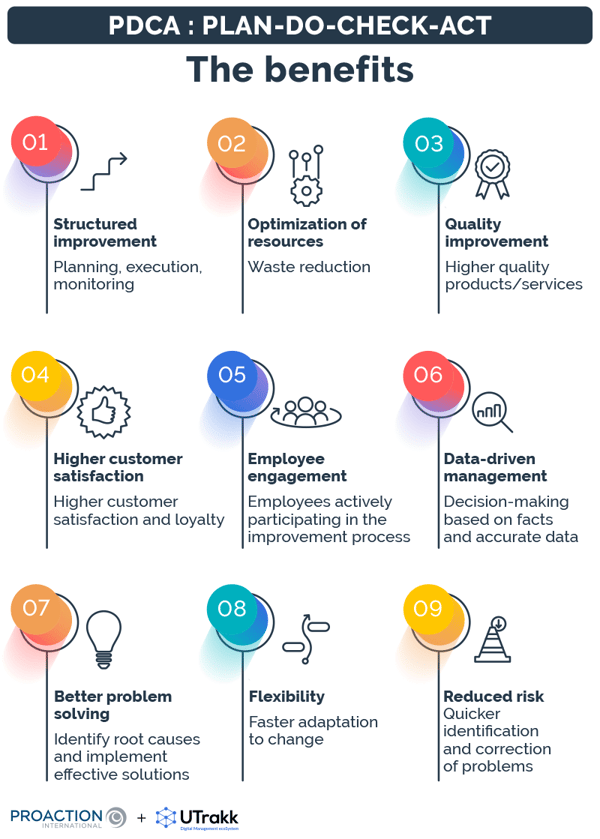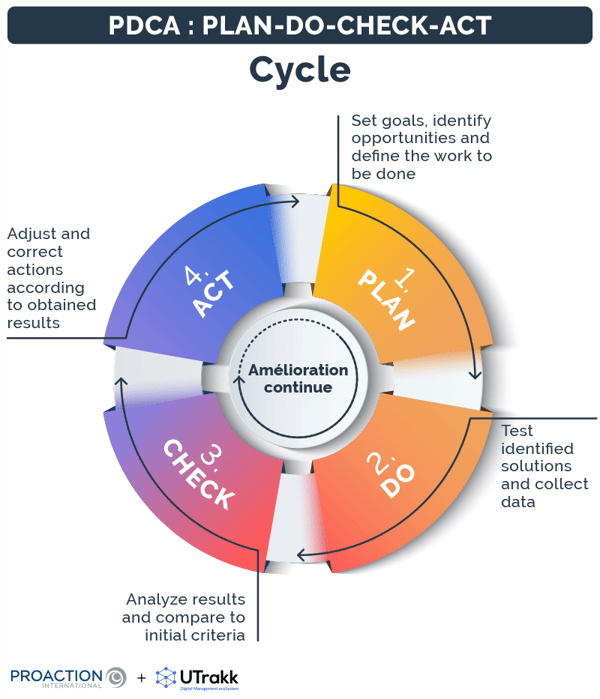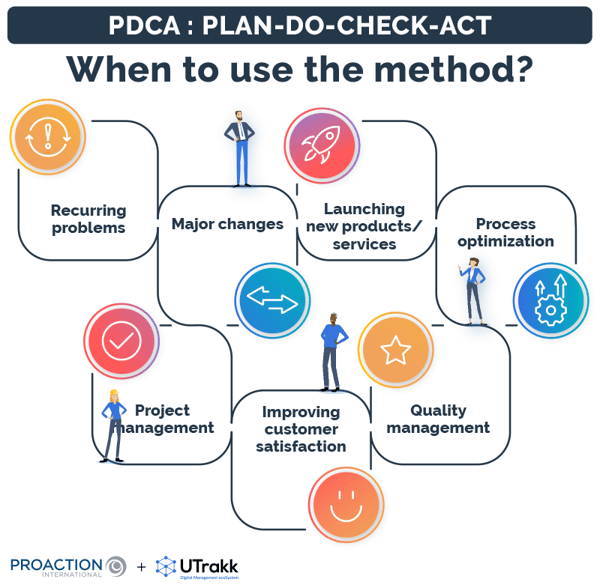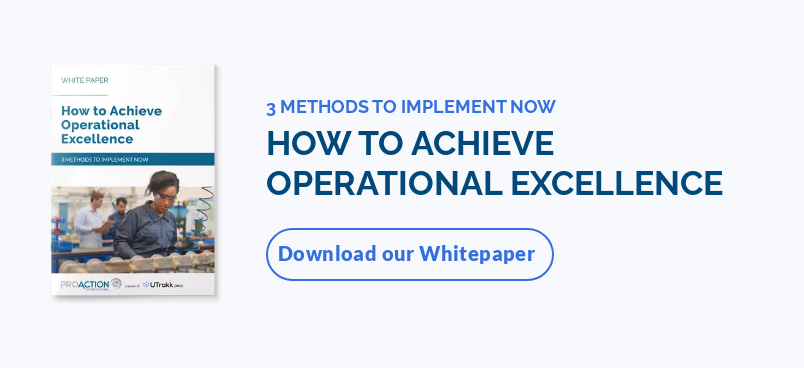What is the PDCA process?
The PDCA cycle, or Deming wheel, is the cornerstone of Lean thinking. Based on the principle of repetition, this scientific method is designed for quality control and process improvements ‒ continuously ‒ with minimal disruption to an organization’s operations.
Although named after Dr. William Edwards Deming, who popularized the “Deming cycle”, the PDCA methodology was initially developed by the American physicist and statistician Walter A. Shewhart (“Shewhart cycle”).
Each letter in the PDCA acronym is associated with a stage in the cycle:
- Plan
- Do
- Check
- Act
The goal of the PDCA cycle is to identify problems and develop multiple solutions, then implement, evaluate, and adjust them continuously. Thus, the PDCA cycle works as a loop of continuous improvement.
PDCA and Lean Management
The PDCA method is an integral part of the Lean Management philosophy, and the two concepts overlap on several points:
- Continuous improvement: Lean Management focuses on the continuous improvement of business processes, the reduction of waste, and the increase of customer value. The PDCA cycle embodies this philosophy, providing a systematic framework for identifying, implementing, evaluating, and adjusting improvements.
- Eliminating waste: One of the main pillars of Lean is the elimination of waste (Muda), such as delays, excessive inventories, unnecessary movements, etc. The PDCA cycle enables these wastes to be identified and reduced in a structured way.
- Lean planning: When Lean initiatives need to be implemented, the PDCA cycle provides a model for strategic planning.
- Standardization and repetition: Lean Management emphasizes the standardization of work processes to ensure consistency and replicability. Plan-Do-Check-Act contributes to this standardization by ensuring improvement measures are based on accurate data and analysis.
- Employee engagement: Lean Management values employee engagement and contribution to continuous improvement. The PDCA process fosters active participation by enabling employees to suggest ideas for improvement and implement the required adjustments.
Benefits of the PDCA method for companies
The PDCA method is widely used in business process management and improvement due to its many benefits:

- Structured improvement: Planning, execution and monitoring, which reduces inefficiencies and the risks of critical issues.
- Optimization of resources: Reduced waste, resulting in cost savings and greater efficiency.
- Quality improvement: Fewer errors and defects throughout processes, resulting in higher-quality products and services.
- Higher customer satisfaction: Continuous improvement of processes, resulting in increased customer satisfaction and loyalty.
- Data-driven management: Decision making based on facts and accurate data, which facilitates business goal achievement.
- Employee engagement: Employees actively participate in the improvement process, resulting in higher engagement and motivation.
- Better problem solving: Identify root causes of ineffective elements to quickly implement solutions.
- Flexibility: Ability to adapt to change to accelerate problem solving.
- Reduced risk: Quicker identification and correction of business problems, lowering operational and process risks.
How to apply the PDCA method (and how UTrakk can support)
Now that you know what is the PDCA method, it's time to apply it. To make it easier, here are detailed explanations of the 4 phases and an handy template to keep them top of mind:

UTrakk continuous improvement software can support you through each step of the PDCA method to ensure that improvement activities are planned, completed on schedule, measured, and adjusted as necessary.
1. Plan phase
The planning stage is vital, enabling you to lay the foundations for subsequent actions.
- Identify a specific problem or opportunity for improvement.
- Set clear, SMART objectives.
- Gather relevant information and data.
- Analyze this data using Pareto diagrams, Ishikawa diagrams, etc.
- Draw up a detailed continuous improvement plan to achieve your project goals (steps to take, responsibilities of each team member, required resources, timetable, etc.).
- Define performance indicators (KPIs) to measure progress.
How UTrakk can support
- Active supervision tours, ritualized audits and checklists: Pinpoint inefficiencies, recurring problems, or variances that indicate where improvements can be made.
- Dashboards: Collect and analyze data to reveal problems and variances.
- KPIs: Set performance goals or standards to reach.
- Actions and Opportunities: Document each action and develop a plan. Convert more complex actions to opportunities and document them just like an action.
2. Do phase
In this phase, the change strategies or improvements identified at the previous stage are implemented in a controlled environment, on a small scale to assess their effectiveness and feasibility.
- Implement the action plan developed in the previous phase.
- Carry out activities in compliance with established guidelines.
- Document changes.
How UTrakk can support
- Actions and Opportunities: Implement the action plans created at the Plan step by following up on tasks to accomplish and set due dates with owners.
- Rituals (meetings): Implement action plans and ensure that all stakeholders are informed and involved.
3. Check phase
This step will help you determine whether the improvements implemented according to the initial plan have provided the desired results or if they require further adjustments.
- Gather data on the results achieved.
- Measure your progress regularly and evaluate performance against targets.
- Monitor the results of changes made at the Do step.
How UTrakk can support
- Rituals (meetings): Discuss the progress on activities, potential obstacles, and results achieved, and determine next steps.
- Dashboards: Collect and analyze data to assess progress on KPIs associated with implemented improvement actions, and see if adjustments are needed.
4. Act phase
If the experiments are successful, you can standardize them and integrate them into your regular operations. Adjust your approach as necessary. Multiple iterations can be repeated until you achieve the desired outcome.
- Make decisions based on the results obtained in the Control phase.
Once these 4 stages have been completed, the PDCA methodology can begin again, leaving room for a new improvement cycle.
How UTrakk can support
- Project tracking: Structure project steps and sub-steps, and define tasks, owners, and due dates to efficiently manage more complex improvement projects, from start to finish.
- Knowledge Center: Document and digitalize best practices and lessons learned for future reference.
- Dashboards: Collect and analyze data to assess progress on KPIs associated with improvement projects, make adjustments where needed, and monitor results on an ongoing basis.
Pro tip: Documenting each step, collecting and analyzing relevant data, and involving stakeholders is essential.
When to use the Plan-Do-Check-Act method?
The PDCA method can be used in many situations to achieve continuous improvement objectives:

- Recurring problems: When your organization faces recurring problems or challenges, the PDCA cycle can be used to solve them systematically. For example, if you regularly experience delays in project delivery, this method can help you identify the underlying causes and find potential solutions.
- Major changes: When introducing significant organizational changes, such as adopting new technology or restructuring, PDCA can help plan, implement, monitor, and adjust such changes in a systematic way.
- New products or services launch: When developing new products or services, PDCA can be used to ensure that your marketing and operational strategies are relevant and that the products and services meet market needs.
- Process optimization: The PDCA cycle is effective for optimizing an existing work process. It can be used to reduce waste, improve efficiency, and ensure that operations run smoothly.
- Quality management: PDCA is commonly used in quality management practices to ensure that standards are met and processes are optimized to meet those standards.
- Customer satisfaction improvement: If you're looking to improve customer satisfaction, Plan-Do-Check-Act can be used to identify areas for improvement, implement an action plan, and assess the impact of improvements on customers.
- Project management: The PDCA cycle can be applied to project planning and management to ensure that the project is planned, executed, monitored, and modified according to set objectives.
Examples of use cases of the PDCA cycle
To give you a better understanding of how the PDCA cycle can be applied in the real world, here are two examples.
1. PDCA cycle in manufacturing
Let’s say you manage a factory and want to reduce the amount of waste produced.
Plan
You realize that your company produces too much waste. Create a plan with clear objectives:
- Identify sources of waste.
- Encourage managers and employees to adopt more sustainable production practices.
- Implement a waste tracking system.
Do
It's time to put your plan into action and meet your objectives:
- Optimize production processes to minimize waste.
- Train managers and employees.
- Track waste generation with better accuracy.
Check
- Collect data on the amount of waste generated before and after the changes are implemented.
- Compare this data with the targets defined in the “Plan” phase.
Act
- Based on the results, make further adjustments to continue reducing waste on an ongoing basis.
2. PDCA cycle in aerospace
You manage an airline and want to reduce aircraft downtime due to maintenance.
Plan
You realize that your aircraft are spending too much time on maintenance, which is impacting your operations. Make a plan with clear objectives:
- Identify the main causes of long maintenance times (inefficient procedures, lack of spare parts, insufficient staff training).
- Adoption of new preventive maintenance practices and ongoing staff training.
Implementation of a system to monitor downtime and spare parts availability.
Do
It's time to put your plan into action and meet your objectives:
- Optimize maintenance processes to reduce downtime.
- Train maintenance technicians in new procedures and techniques.
- Set up a real-time tracking system for spare parts and downtime.
Check
- Collect data on aircraft downtime before and after implementing the changes, and compare them with the targets defined in the previous phase.
- Analyze the results to measure the impact of the new maintenance practices.
- Identify any discrepancies between the results obtained and the targets set.
Act
- Based on the results, make further adjustments to continue reducing aircraft downtime.
PDCA and UTrakk: A powerful duo for operational excellence
The PDCA model is a powerful tool for continuous process improvement in various industries and areas of operation. It offers a structured approach to planning, implementing, evaluating, and adjusting initiatives. With this scientific method, organizations can solve problems, optimize their operations, and adapt effectively to a constantly changing environment.
In the quest for operational excellence, the PDCA method and UTrakk DMS are obvious partners, as the software solution strengthens the implementation of the continuous improvement cycle. With UTrakk, the PDCA process is rigorously and methodically applied, fostering innovation, efficiency, and the highest levels of performance.











